Con esta entrada comienzo una serie de posts dedicada al patchwork. Las consultas de mis alumnas cuando comienzan el taller de Patchwork en The Crafty Room de y mis lectores de Deshilachado me han animado a ordenar y poner por escrito mis conocimientos y experiencias.
With this one I start a series of posts dedicated to the patchwork. The enquiries of my pupils when they begin in The Crafty Room and my readers on Deshilachado have encouraged me to bring order and write down my knowledge and experiences.
Comenzamos por el principio, es decir, por los materiales y herramientas necesarios. Si vuestra idea es probar con el patchwork para ver si os gusta no os aconsejo que compréis nada especial, con vuestro costurero tendréis bastante para empezar. Si os animáis a seguir podéis ir comprando materiales específicos que os harán la labor más fácil y os ayudarán a obtener mejores resultados.
Let’s start from the beginning, that means, the necessary materials and tools. If your idea is to try patchwork and see if you like it, I advise you not to buy anything special, with your sewing box you will have enough to start. Later, if you decide to continue with it, you can buy specific materials that will make your work easier and will help you to obtain better results.
- Agujas: de distintos tamaños y grosores para las distintas fases de elaboración del quilt: para coser las adecuadas a cada tela y para acolchar finas y cortas (ver aquí). Igualmente, si coséis a máquina cambiad el grosor de la aguja según sea necesario.
- Needles: different sizes and thicknesses for the different stages of the quilt: to sew, the adapted to every fabric, and to quilt, thin and short (see here). Also, if you use a sewing machine, change the thickness of the needle when required.
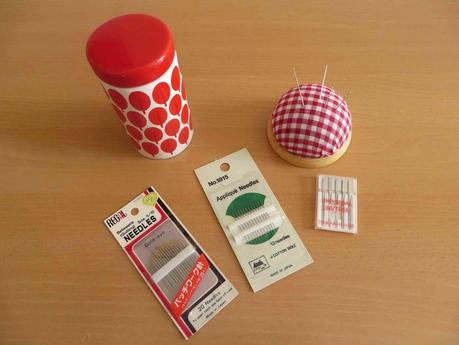
- Alfileres: para unir piezas utilizamos los alfileres habituales de costura, pero para acolchar existen alfileres largos, finos y con cabeza grande, que permiten sujetar bien las capas del quilt. Y para aplicaciones los alfileres son muy cortos.
- Pins: use the sewing pins to join pieces, but there are long, thin and big-headed pins to quilt, which allow to hold the different layers. And for appliqués, the pins are very short.
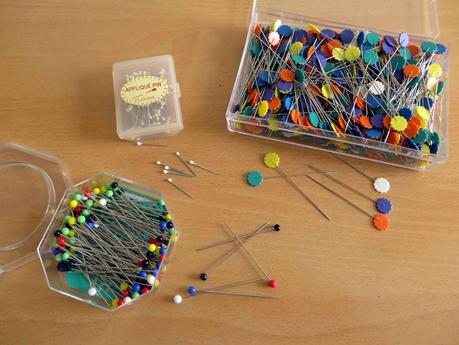
- Imperdibles: se emplean para unir las capas del quilt y aunque sirven los normales, los especiales para patchwork tienen los dos lados curvados, lo que facilita su colocación y evita que se aplaste la guata.
- Safety pins: they are used to join the layers of the quilt and though the usual ones are useful, the special for patchwork have both sides curved, which facilitates its use and prevent from squasing the filling.

- Dedales: para unir las piezas se usan los dedales de costura, pero para acolchar a mano hay dedales especiales, de silicona, de piel,... Se trata de elegir el que nos resulte más cómodo. Incluso para las que nos disgusta usar dedal éste es esencial para acolchar porque las agujas son muy finas, así que es inevitable que nos las clavemos.
- Thimbles: use the sewing thimbles to join the pieces, but there are special thimbles to quilt by hand, made of silicone, of skin... The question is to choose the one you find more comfortable. Even for those who doesn’t like to use thimble, this one is essential for quilting because the needles are very thin, so it’s inevitable that we get it in our skin.
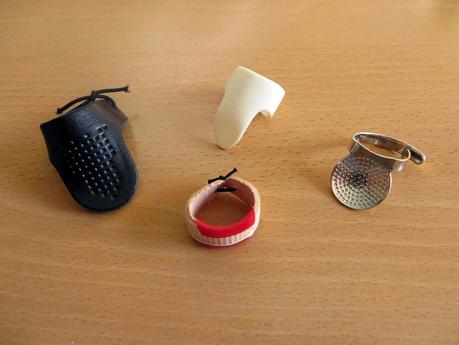
- Descosedor: una herramienta imprescindible para deshacer las costuras sin que sufra la tela. En muchas ocasiones he visto utilizarlo mal: no se abren las costuras y se van cortando, sino que se cortan pespuntes a una distancia de unos dos-tres centímetros por la parte delantera de la labor y se tira del hilo por el revés de la tela o por la trasera del quilt, según el caso.
- Unstitcher: an essential tool to unstitich the seams without damage the fabric. In many cases it is misused: the seams should not be opened and cut, but backstitchings have to be cut to a distance of approximately two or three centimeters on the front of the work and the thread pulled by the reverse side of the fabric or the back of the quilt, depending on the case.
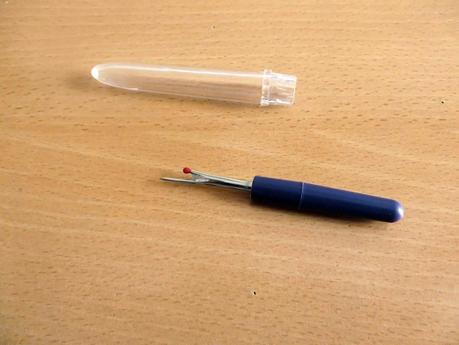
- Tijeras: una norma básica es no emplear la misma tijera para cortar papel y tela, porque se desafila la hoja de la tijera. Además, para cortar tela se deben usar tijeras de costura y para zonas pequeñas o cortar hilos tijeras de bordar, que son pequeñas y curvadas.
- Scissors: a basic rule is not to use the same scissors to cut paper and fabric, because the leaf of the scissors gets blund. Besides, sewing scissors must be used for cutting fabrics and embroidering scissors for small areas or cutting threads, as they are small and curvded.

- Cúter: en patchwork se utilizan circulares. Son muy útiles para acelerar la fase de corte de las piezas, pero hay que saber emplearlos. Se trata de practicar hasta lograr hacer un corte preciso y sin interrupciones de una sola pasada. En mi opinión, es realmente útil cuando aprendemos a sacar las piezas sin dibujarlas previamente, lo que requiere experiencia en el uso de las reglas y en calcular el margen de costura al cortar y coser. Por eso yo no tengo prisa en que mis alumnas aprendan a usarlo.
- Cutter: in patchwork are used circular ones. They are very useful to speed the process of cutting the pieces, but it is necessary to know how to use it. The question is to practise till being able to make a precise cut and with no interruptions in one single pass. In my opinion, it is really useful when we learn how to get the pieces without drawing them previously, which needs experience in using the rulers and in calculating the seam allowance when cutting and sewing. That’s why I prefer not to hurry my pupils to use it.
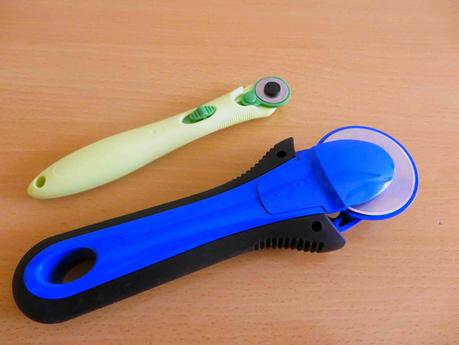
- Alfombrilla graduada, base o "mat": la enumero en este momento porque para cortar con el cúter se debe hacer sobre ella. Pero también es una herramienta de medición que comentaré en el próximo post, junto con las reglas y plantillas.
- Self-healing mat: I name it now because when cutting with the cutter it’s necessary to do it on it. But it’s also a measurement tool that I will comment on next post, together with the rulers and templates.
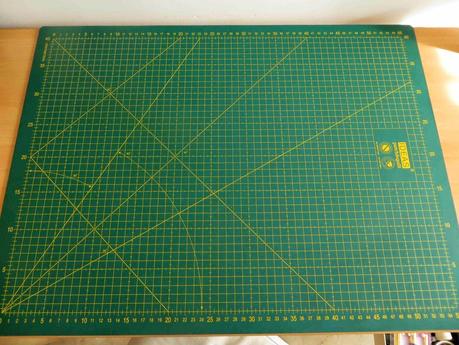
- Lápices, bolígrafos y rotuladores solubles: los rotuladores solubles se van con agua o con calor. A mi me gustan los primeros porque los otros teóricamente los borras cuando quieres pasando la plancha, pero con la fricción al trabajar la labor también se borran y eso es un verdadero problema si ocurre a mitad de proceso. De todas formas, estos rotuladores son caros en comparación con un lápiz normal o incluso un bolígrafo, así que yo uso estos últimos para dibujar las piezas y los rotuladores solubles sólo para aplicaciones y bordados, piezas que van en el top del quilt, por lo que deben quedar limpias. Habitualmente empleo lápices de mina porque marco con más precisión el tamaño de las piezas, pues puedo acercarlos lo más posible a la regla. El bolígrafo es mi recurso para telas con colores donde es difícil distinguir el lápiz. Quizá no es muy ortodoxo, pero sí útil y efectivo ¡Y nadie se va a enterar! Je, je.
- Pencils, ballpens and fabric markers: washaway pens ink can be removed with water or heat. I prefer the first ones because friction when working can also erase the ink of the other ones and this can be a real problem. Anyway, these felt-tip pens are expensive in comparison with a normal pencil or even a pen, so I use this last ones to draw the pieces and the soluble pens just for appliqués and embroideries, pieces which go at the top of the quilt. Therefore they must be clean. Usually, I use leadholders because I can mark with greater precision the size of the pieces, as I can bring it much closer to the rule. The pen is my resource for colored fabrics where is difficult to distinguish the pencil. Probably it is not very orthodox, but is useful and effective and nobody is going to find out!
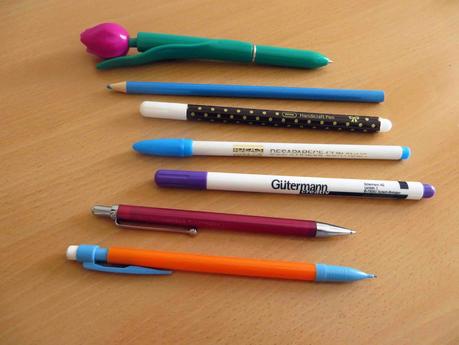
En el próximo post hablaremos de reglas, plantillas, materiales de pegado,... Espero que os haya resultado útil.
On the next post we will talk about rulers, templates, glues... I hope you’ve found it useful.

